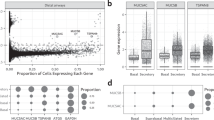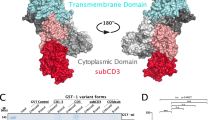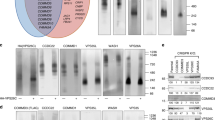Abstract
REGULATED fusion of secretory granules with the plasma membrane in secretory cells requires ATP, Ca2+ and cytosolic1-3 as well as membrane4 proteins. ATP-dependent steps in Ca2+-activated secretion from PC 12 cells require three cytosolic PEP proteins (priming in exocytosis proteins, PEP1–3)5,6, the identity of which will provide insights into the required ATP-using reactions. PEP3 was recently identified as phosphatidylinositol transfer protein (PtdlnsTP)6, and here we report that PEP1 consists of the type I phosphatidylinositol-4-phosphate 5-kinase (PtdlnsPSK). The roles of PEP3/PtdInsTP and PEP1/ PtdlnsPSK in sequential phosphoinositide recruitment and phosphorylation explains their synergistic activity in ATP-dependent priming. Moreover, inhibition of Ca2+-activated secretion by PtdIns(4,5)P2-specific antibodies and phospholipase C implies that 5-phosphorylated inositides play a novel, necessary role in the regulated secretory pathway. The results indicate that lipid kinase-mediated phosphorylation is an important basis for ATP use in the exocytotic pathway.
This is a preview of subscription content, access via your institution
Access options
Subscribe to this journal
Receive 51 print issues and online access
$199.00 per year
only $3.90 per issue
Buy this article
- Purchase on Springer Link
- Instant access to full article PDF
Prices may be subject to local taxes which are calculated during checkout
Similar content being viewed by others
References
Walent, J. H., Porter, B. W. & Martin, T. F. J. Cell 70, 765–775 (1992).
Morgan, A. & Burgoyne, R. D. Nature 355, 833–836 (1992).
Wu, Y. N., Vu, N.-D. & Wagner, P. D. Biochem. J. 285, 697–700 (1992).
Söllner, T. et al. Nature 362, 318–324 (1993).
Hay, J. C. & Martin, T. F. J. J. Cell Biol. 119, 139–151 (1992).
Hay, J. C. & Martin, T. F. J. Nature 366, 572–575 (1993).
Helmkamp, G. M. Jr, Harvey, M. S., Wirtz, K. W. A. & van Deenen, L. L. M. J. biol. Chem. 249, 6382–6389 (1974).
Cleves, A. E. et al. Cell 64, 789–800 (1991).
McGee, T. P., Skinner, H. B., Whitters, E. A., Henry, S. A. & Bankaitis, V. A. J. Cell Biol. 124, 273–287 (1994).
Thomas, G. M. H. et al. Cell 74, 919–928 (1993).
Carpenter, C. L. & Cantley, L. C. Biochemistry 29, 11147–11156 (1990).
Jenkins, G. H., Fisette, P. L. & Anderson, R. A. J. biol. Chem. 269, 11547–11554 (1994).
Scholz, G., Barritt, G. J. & Kwok, F. Eur. J. Biochem. 210, 461–466 (1992).
Bazenet, C. E., Ruano, A. R., Brockman, J. L. & Anderson, R. A. J. biol. Chem. 265, 18012–18022 (1990).
Schu, P. V. et al. Science 260, 88–91 (1993).
Fukami, K. et al. Nature 359, 150–152 (1992).
Eberhard, D. A., Cooper, C. L. Low, M. G. & Holz, R. W. Biochem. J. 268, 15–25 (1990).
Phillips, J. H. Biochem. J. 136, 579–587 (1973).
Tagaya, M., Wilson, D. W., Brunner, M., Arango, N. & Rothman, J. E. J. biol. Chem. 268, 2662–2666 (1993).
Harlan, J. E., Hajduk, P. J., Yoon, H. S. & Fesik, S. W. Nature 371, 168–170 (1994).
Perrin, D., Langley, O. K. & Aunis, D. Nature 326, 498–501 (1987).
Anderson, R. A. & Marchesi, V. T. Nature 318, 295–298 (1985).
Janmey, P. A. A. Rev. Physiol. 56, 169–191 (1994).
Bittner, M. A. & Holz, R. W. Cell. molec. Neurobiol. 13, 649–663 (1993).
Lawrence, G. W., Weller, U. & Dolly, J. O. Eur. J. Biochem. 222, 325–333 (1994).
Brown, H. A., Gutowski, S., Moomaw, C. R., Slaughter, C. & Sternweis, P. C. Cell 75, 1137–1144 (1993).
Liscovitch, M., Chalifa, V., Pertile, P., Chen, C.-S. & Cantley, L. C. J. biol. Chem. 269, 21403–21406 (1993).
Laemmli, U. K. Nature 227, 680–695 (1970).
Burnette, W. R. Analyt. Biochem. 112, 195–203 (1981).
Ausubel, F. M. et al. Current Protocols in Molecular Biology (Wiley, New York, 1994).
Author information
Authors and Affiliations
Rights and permissions
About this article
Cite this article
Hay, J., Fisette, P., Jenkins, G. et al. ATP-dependent inositide phosphorylation required for Ca2+-activated secretion. Nature 374, 173–177 (1995). https://doi.org/10.1038/374173a0
Received:
Accepted:
Issue Date:
DOI: https://doi.org/10.1038/374173a0
This article is cited by
-
Insulin granule biogenesis and exocytosis
Cellular and Molecular Life Sciences (2021)
-
Resolving kinetic intermediates during the regulated assembly and disassembly of fusion pores
Nature Communications (2020)
-
Tied up: Does altering phosphoinositide-mediated membrane trafficking influence neurodegenerative disease phenotypes?
Journal of Genetics (2018)
-
The Role of Phosphoinositides in Synapse Function
Molecular Neurobiology (2014)
-
Phosphatidylinositol 4-Kinases and PI4P Metabolism in the Nervous System: Roles in Psychiatric and Neurological Diseases
Molecular Neurobiology (2013)
Comments
By submitting a comment you agree to abide by our Terms and Community Guidelines. If you find something abusive or that does not comply with our terms or guidelines please flag it as inappropriate.



